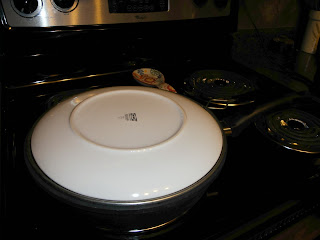I love having plants around the house. They make the air seem fresher, and bring a little bit of nature inside during these long winter days (even though we are experiencing much higher than normal temperatures, and it could pretty much be April now...).
However much I love plants, I adore flowering plants even more. It is very tempting to view flowers as nothing more than beautiful adornments that the plant puts on for our enjoyment. Of course, this is not true; flowers are the advertisement to get pollinators to come and sample the plants wares (usually nectar) in exchange for carrying a little bit of pollen to another plant in hopes of acheiving fertilization.
(Aside: while discussing Brownian motion with my 15 year old students, I asked if any one remembered what pollen actually was. Just as soon as I finished asking, one boy shouts "TREE SPERM!". A funny reminder that no matter how much I love flowers, the point is for the plant to have a bit of sexy times.)
Plants are often very particular about when they will decide to flower; just like an animal will come into heat at a particular time. It's all about increasing the chances of successfully being fertilized. There's not much point in putting out flowers if you are the only one... who will you exchange gametes with?
As such, getting certain houseplants to flower can be tricky. Some plants are triggered by a change in temperature or daylight hours (which would correspond to a particular season in their native habitat) which often is not met in climate-controlled homes.
 |
| Phalaenopsis. |
Orchids are a particularly fussy plant to get to bloom. When you buy an orchid from the store, it comes with beautiful blossoms, which can last for a fairly long time. But eventually they will fall off, leaving you with a sad looking little plant. Most people decide it's not worth the hassle of encouraging their orchids to re-flower and will just chuck the old one out and buy a new one.
By sheer accident, I discovered a pretty easy way to encourage my orchids to re-flower. (When I'm not busy killing them that is... orchids are a non-parasitic plant, or ephiphyte, that will live on the branches of trees in the rainforests, and are evolved to soak up the tiniest bit of moisture from their surroundings. This makes them prone to root rot when you are a little too vigorous with the watering can, like I can be...)
 |
| Dendrobium. |
Anyways, I was gifted a bunch of non-flowering orchids in June by a colleague who retired and moved out to the coast. The Phalaenopsis orchids (what you usually buy in the store) were almost blooming, so I left them in my kitchen, but there was a Dendrobium orchid that I had no idea what to do with. Dendrobium orchids are quite different looking than Phalaenopsis orchids; they have a cane like structure, with leaves growing out the top, almost like a palm tree. I thought it would look quite nice in my bedroom, and left it on top of my filing cabinet for about 5 months.
In order to encourage orchids to flower, they are often put in a cool, dark place for several weeks, and brought back into the light when they form buds. I had no idea that I had put my Dendrobuim orchid into these exact conditions until I went to water it one day and discovered that it had a bud! I was so excited.
The Dendrobium has since been moved to my kitchen, where it's delicate blooms can be better enjoyed, (see picture above!) and I've relocated some Phalaenopsis orchids to my filing cabinet to try again!
 At the beginning of January, my dear friend Heather came up to visit me from Calgary. We have been BFF's since about Kindergarten, and even if we don't get to see each other as often as we'd like, I always try to make some time to hang out. We have always enjoyed cooking and baking together, and the weekend was no exception. For dessert, we made the easiest Key Lime Pie recipe (her mother's) with the Key Lime juice she brought me back from Florida. It's super light and would be excellent in the summer time, but it was delightful even in January.
At the beginning of January, my dear friend Heather came up to visit me from Calgary. We have been BFF's since about Kindergarten, and even if we don't get to see each other as often as we'd like, I always try to make some time to hang out. We have always enjoyed cooking and baking together, and the weekend was no exception. For dessert, we made the easiest Key Lime Pie recipe (her mother's) with the Key Lime juice she brought me back from Florida. It's super light and would be excellent in the summer time, but it was delightful even in January. 













